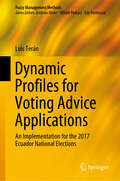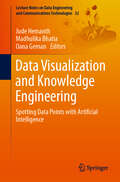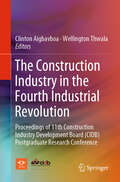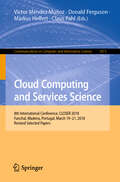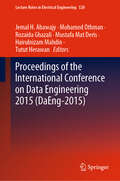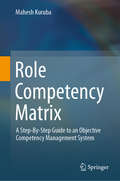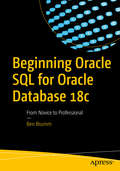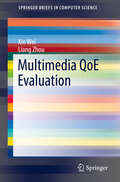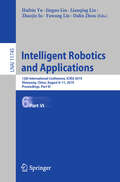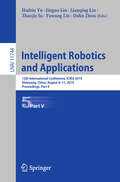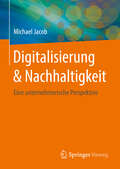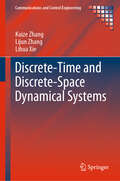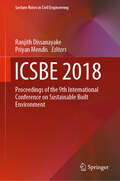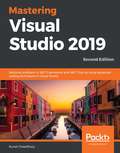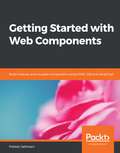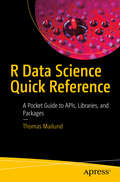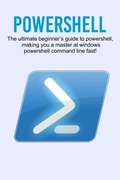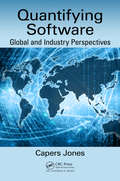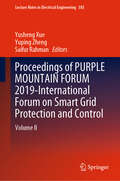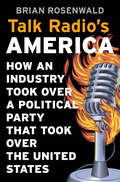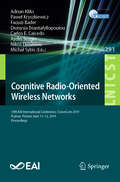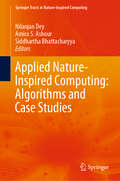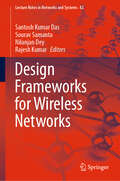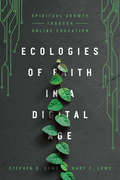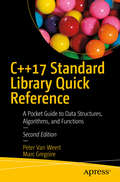- Table View
- List View
Dynamic Profiles for Voting Advice Applications: An Implementation for the 2017 Ecuador National Elections (Fuzzy Management Methods)
by Luis TeránElectronic participation is an emerging and growing research area that makes use of internet solutions to enhance citizens' participation in government processes in order to provide a fair and efficient society. This book examines recommender-system technologies and voting advice applications as tools to enable electronic citizen participation during election campaigns. Further, making use of fuzzy classification, it provides an evaluation framework for eParticipation. A dynamic voting advice application developed for the 2017 Ecuador national election serves as a real-world case study to introduce readers to the practical implementation and evaluation issues. The book concludes with a comprehensive analysis of the 2017 election project based on altmetrics, Google Analytics and statistics from the case study.
Data Visualization and Knowledge Engineering: Spotting Data Points with Artificial Intelligence (Lecture Notes on Data Engineering and Communications Technologies #32)
by Jude Hemanth Madhulika Bhatia Oana GemanThis book presents the fundamentals and advances in the field of data visualization and knowledge engineering, supported by case studies and practical examples. Data visualization and engineering has been instrumental in the development of many data-driven products and processes. As such the book promotes basic research on data visualization and knowledge engineering toward data engineering and knowledge. Visual data exploration focuses on perception of information and manipulation of data to enable even non-expert users to extract knowledge. A number of visualization techniques are used in a variety of systems that provide users with innovative ways to interact with data and reveal patterns. A variety of scalable data visualization techniques are required to deal with constantly increasing volume of data in different formats. Knowledge engineering deals with the simulation of the exchange of ideas and the development of smart information systems in which reasoning and knowledge play an important role. Presenting research in areas like data visualization and knowledge engineering, this book is a valuable resource for students, scholars and researchers in the field. Each chapter is self-contained and offers an in-depth analysis of real-world applications. It discusses topics including (but not limited to) spatial data visualization; biomedical visualization and applications; image/video summarization and visualization; perception and cognition in visualization; visualization taxonomies and models; abstract data visualization; information and graph visualization; knowledge engineering; human–machine cooperation; metamodeling; natural language processing; architectures of database, expert and knowledge-based systems; knowledge acquisition methods; applications, case studies and management issues: data administration issues and knowledge; tools for specifying and developing data and knowledge bases using tools based on communication aspects involved in implementing, designing and using KBSs in cyberspace; Semantic Web.
The Construction Industry in the Fourth Industrial Revolution: Proceedings of 11th Construction Industry Development Board (CIDB) Postgraduate Research Conference
by Clinton Aigbavboa Wellington ThwalaThis book gathers papers from the 11th Construction Industry Development Board (cidb) Postgraduate Research Conference, held on 28–30 July 2019 in Johannesburg, South Africa. The conference provided an essential forum for reviewing and generating knowledge on Construction 4.0 and, consequently, highlighted processes and practices that allow us to deliver and operate built environment assets more effectively and efficiently by focusing on physical-to-digital and digital-to-physical transformation. The event addressed three broad themes: Industrial production (prefabrication, 3-D printing and assembly, offsite and advanced manufacturing);Cyber-physical systems (actuators, sensors, IoT, robots and cobots for repetitive and dangerous tasks, and drones for mapping, progress monitoring, safety and quality inspections, lifting, moving and positioning); and Technologies (digital ecosystems, digital platforms, BIM, video and laser scanning, AI and cloud computing, big data and data analytics, reality capture, blockchain, simulation, virtual and augmented reality, data standards and interoperability, and vertical and horizontal integration). Given its scope, the book will be of interest to all construction industry and architectural professionals who want to learn about cutting-edge technologies applied to construction
Cloud Computing and Services Science: 8th International Conference, CLOSER 2018, Funchal, Madeira, Portugal, March 19-21, 2018, Revised Selected Papers (Communications in Computer and Information Science #1073)
by Víctor Méndez Muñoz Donald Ferguson Markus Helfert Claus PahlThis book constitutes extended, revised and selected papers from the 8th International Conference on Cloud Computing and Services Science, CLOSER 2018, held in Funchal, Portugal in March 2018. The 11 papers presented in this volume were carefully reviewed and selected from a total of 94 submissions. CLOSER 2018 focused on the emerging area of Cloud Computing, inspired by some latest advances that concern the infrastructure, operations and available services throughout the global network.
Proceedings of the International Conference on Data Engineering 2015 (Lecture Notes in Electrical Engineering #520)
by Jemal H. Abawajy Mohamed Othman Rozaida Ghazali Mustafa Mat Deris Hairulnizam Mahdin Tutut HerawanThese proceedings gather outstanding research papers presented at the Second International Conference on Data Engineering 2015 (DaEng-2015) and offer a consolidated overview of the latest developments in databases, information retrieval, data mining and knowledge management. The conference brought together researchers and practitioners from academia and industry to address key challenges in these fields, discuss advanced data engineering concepts and form new collaborations. The topics covered include but are not limited to: • Data engineering • Big data • Data and knowledge visualization • Data management • Data mining and warehousing • Data privacy & security • Database theory • Heterogeneous databases • Knowledge discovery in databases • Mobile, grid and cloud computing • Knowledge management • Parallel and distributed data • Temporal data • Web data, services and information engineering • Decision support systems • E-Business engineering and management • E-commerce and e-learning • Geographical information systems • Information management • Information quality and strategy • Information retrieval, integration and visualization • Information security • Information systems and technologies
Role Competency Matrix: A Step-By-Step Guide to an Objective Competency Management System
by Mahesh KurubaThis book discusses the Role Competency Matrix (RCM), a competency management system framework that helps organizations to quantify and manage workforce competencies and align them to business needs. An objective and transparent system for both employees and managers alike, the RCM helps managers make quantitative decisions to develop strategies for staffing needs, competency development, career progression and succession planning in the workforce. It also helps employees to identify the roles suited to their aspirations and capabilities and to take responsibility for their development.“The right people for the right roles” is key to effective workforce management, and workforce competencies must be optimally deployed to improve productivity, enhance job satisfaction and reduce attrition. At the same time, information technology (IT) businesses are under constant pressure to respond quickly to the ever-changing technology and business trends. Although, some organizations take a myopic “hire and fire” approach, in order to succeed, an organization must continually upgrade its workforce’s competencies in line with new demands.
Beginning Oracle SQL for Oracle Database 18c: From Novice to Professional
by Ben BrummStart developing with Oracle SQL. This book is a one-stop introduction to everything you need to know about getting started developing an Oracle Database. You'll learn about foundational concepts, setting up a simple schema, adding data, reading data from the database, and making changes. No experience with databases is required to get started. Examples in the book are built around Oracle Live SQL, a freely available, online sandbox for practicing and experimenting with SQL statements, and Oracle Express Edition, a free version of Oracle Database that is available for download.A marquee feature of Beginning Oracle SQL for Oracle Database 18c is the small chapter size. Content is divided into easily digestible chunks that can be read and practiced in very short intervals of time, making this the ideal book for a busy professional to learn from. Even just a 15-20 minute block of free time can be put to good use.Author Ben Brumm begins by helping you understand what a database is, and getting you set up with a sandbox in which to practice the SQL that you are learning. From there, easily digestible chapters cover, point-by-point, the different aspects of writing queries to get data out of a database. You’ll also learn about creating tables and getting data into the database. Crucial topics such as working with nulls and writing analytic queries are given the attention they deserve, helping you to avoid pitfalls when writing queries for production use.What You'll LearnCreate, update, and delete tables in an Oracle databaseAdd, update, delete data from those database tablesQuery and view data stored in your databaseManipulate and transform data using in-built database functions and featuresCorrectly choose when to use Oracle-specific syntax and featuresWho This Book Is ForThose new to Oracle who are planning to develop software using Oracle as the back-end data store. The book is also for those who are getting started in software development and realize they need to learn some kind of database language. Those who are learning software development on the side of their normal job, or learning it as a college student, who are ready to learn what a database is and how to use it also will find this book useful.
Multimedia QoE Evaluation (SpringerBriefs in Computer Science)
by Xin Wei Liang ZhouThis SpringerBrief discusses the most recent research in the field of multimedia QoE evaluation, with a focus on how to evaluate subjective multimedia QoE problems from objective techniques. Specifically, this SpringerBrief starts from a comprehensive overview of multimedia QoE definition, its influencing factors, traditional modeling and prediction methods. Subsequently, the authors introduce the procedure of multimedia service data collection, preprocessing and feature extractions. Then, describe several proposed multimedia QoE modeling and prediction techniques in details. Finally, the authors illustrate how to implement and demonstrate multimedia QoE evaluation in the big data platform. This SpringerBrief provides readers with a clear picture on how to make full use of multimedia service data to realize multimedia QoE evaluation. With the exponential growth of the Internet technologies, multimedia services become immensely popular. Users can enjoy multimedia services from operators or content providers by TV, computers and mobile devices. User experience is important for network operators and multimedia content providers. Traditional QoS (quality of service) can not entirely and accurately describe user experience. It is natural to research the quality of multimedia service from the users’ perspective, defined as multimedia quality of experience (QoE). However, multimedia QoE evaluation is difficult, because user experience is abstract and subjective, hard to quantify and measure. Moreover, the explosion of multimedia service and emergence of big data, all call for a new and better understanding of multimedia QoE.This SpringerBrief targets advanced-level students, professors and researchers studying and working in the fields of multimedia communications and information processing. Professionals, industry managers, and government research employees working in these same fields will also benefit from this SpringerBrief.
Intelligent Robotics and Applications: 12th International Conference, ICIRA 2019, Shenyang, China, August 8–11, 2019, Proceedings, Part VI (Lecture Notes in Computer Science #11745)
by Haibin Yu Jinguo Liu Lianqing Liu Zhaojie Ju Yuwang Liu Dalin ZhouThe volume set LNAI 11740 until LNAI 11745 constitutes the proceedings of the 12th International Conference on Intelligent Robotics and Applications, ICIRA 2019, held in Shenyang, China, in August 2019. The total of 378 full and 25 short papers presented in these proceedings was carefully reviewed and selected from 522 submissions. The papers are organized in topical sections as follows:Part I: collective and social robots; human biomechanics and human-centered robotics; robotics for cell manipulation and characterization; field robots; compliant mechanisms; robotic grasping and manipulation with incomplete information and strong disturbance; human-centered robotics; development of high-performance joint drive for robots; modular robots and other mechatronic systems; compliant manipulation learning and control for lightweight robot. Part II: power-assisted system and control; bio-inspired wall climbing robot; underwater acoustic and optical signal processing for environmental cognition; piezoelectric actuators and micro-nano manipulations; robot vision and scene understanding; visual and motional learning in robotics; signal processing and underwater bionic robots; soft locomotion robot; teleoperation robot; autonomous control of unmanned aircraft systems. Part III: marine bio-inspired robotics and soft robotics: materials, mechanisms, modelling, and control; robot intelligence technologies and system integration; continuum mechanisms and robots; unmanned underwater vehicles; intelligent robots for environment detection or fine manipulation; parallel robotics; human-robot collaboration; swarm intelligence and multi-robot cooperation; adaptive and learning control system; wearable and assistive devices and robots for healthcare; nonlinear systems and control. Part IV: swarm intelligence unmanned system; computational intelligence inspired robot navigation and SLAM; fuzzy modelling for automation, control, and robotics; development of ultra-thin-film, flexible sensors, and tactile sensation; robotic technology for deep space exploration; wearable sensing based limb motor function rehabilitation; pattern recognition and machine learning; navigation/localization. Part V: robot legged locomotion; advanced measurement and machine vision system; man-machine interactions; fault detection, testing and diagnosis; estimation and identification; mobile robots and intelligent autonomous systems; robotic vision, recognition and reconstruction; robot mechanism and design. Part VI: robot motion analysis and planning; robot design, development and control; medical robot; robot intelligence, learning and linguistics; motion control; computer integrated manufacturing; robot cooperation; virtual and augmented reality; education in mechatronics engineering; robotic drilling and sampling technology; automotive systems; mechatronics in energy systems; human-robot interaction.
Intelligent Robotics and Applications: 12th International Conference, ICIRA 2019, Shenyang, China, August 8–11, 2019, Proceedings, Part V (Lecture Notes in Computer Science #11744)
by Haibin Yu Jinguo Liu Lianqing Liu Zhaojie Ju Yuwang Liu Dalin ZhouThe volume set LNAI 11740 until LNAI 11745 constitutes the proceedings of the 12th International Conference on Intelligent Robotics and Applications, ICIRA 2019, held in Shenyang, China, in August 2019. The total of 378 full and 25 short papers presented in these proceedings was carefully reviewed and selected from 522 submissions. The papers are organized in topical sections as follows:Part I: collective and social robots; human biomechanics and human-centered robotics; robotics for cell manipulation and characterization; field robots; compliant mechanisms; robotic grasping and manipulation with incomplete information and strong disturbance; human-centered robotics; development of high-performance joint drive for robots; modular robots and other mechatronic systems; compliant manipulation learning and control for lightweight robot. Part II: power-assisted system and control; bio-inspired wall climbing robot; underwater acoustic and optical signal processing for environmental cognition; piezoelectric actuators and micro-nano manipulations; robot vision and scene understanding; visual and motional learning in robotics; signal processing and underwater bionic robots; soft locomotion robot; teleoperation robot; autonomous control of unmanned aircraft systems. Part III: marine bio-inspired robotics and soft robotics: materials, mechanisms, modelling, and control; robot intelligence technologies and system integration; continuum mechanisms and robots; unmanned underwater vehicles; intelligent robots for environment detection or fine manipulation; parallel robotics; human-robot collaboration; swarm intelligence and multi-robot cooperation; adaptive and learning control system; wearable and assistive devices and robots for healthcare; nonlinear systems and control. Part IV: swarm intelligence unmanned system; computational intelligence inspired robot navigation and SLAM; fuzzy modelling for automation, control, and robotics; development of ultra-thin-film, flexible sensors, and tactile sensation; robotic technology for deep space exploration; wearable sensing based limb motor function rehabilitation; pattern recognition and machine learning; navigation/localization. Part V: robot legged locomotion; advanced measurement and machine vision system; man-machine interactions; fault detection, testing and diagnosis; estimation and identification; mobile robots and intelligent autonomous systems; robotic vision, recognition and reconstruction; robot mechanism and design. Part VI: robot motion analysis and planning; robot design, development and control; medical robot; robot intelligence, learning and linguistics; motion control; computer integrated manufacturing; robot cooperation; virtual and augmented reality; education in mechatronics engineering; robotic drilling and sampling technology; automotive systems; mechatronics in energy systems; human-robot interaction.
Digitalisierung & Nachhaltigkeit: Eine unternehmerische Perspektive
by Michael JacobDie Themen Digitalisierung und Nachhaltigkeit dominieren die Zukunft von Unternehmen und unserer Gesellschaft in den nächsten Jahrzehnten. Wenn Unternehmen die Digitalisierung aktiv umsetzen, müssen sie folglich ökonomische, ökologische und soziale Aspekte im Sinne der Nachhaltigkeit berücksichtigen. Genau hier setzt Michael Jacob an: Der Autor geht im ersten Teil des Buches auf die Grundlagen der Digitalisierung und Nachhaltigkeit anhand der wichtigsten Modelle ein. Im zweiten Teil wird der Fokus auf die Frage gelegt, wie Unternehmen den Digitalisierungsprozess nachhaltig gestalten können. Ein kurzes Fazit rundet die beiden Hauptteile ab.Damit ist das Buch ein wichtiges Hilfsmittel, um Zielkonflikte zwischen den Bereichen Digitalisierung und Nachhaltigkeit zunächst zu erkennen und dann entsprechend entscheiden zu können. Somit können Unternehmen ihrer gesellschaftlichen Verantwortung (Corporate Social Responsibility) nachkommen. Ein Buch für alle, die eine kompakte Einführung in die beiden großen Themen unserer Zeit suchen.
Discrete-Time and Discrete-Space Dynamical Systems (Communications and Control Engineering)
by Kuize Zhang Lijun Zhang Lihua XieDiscrete-Time and Discrete-Space Dynamical Systems provides a systematic characterization of the similarities and differences of several types of discrete-time and discrete-space dynamical systems, including:Boolean control networks;nondeterministic finite-transition systems;finite automata;labelled Petri nets; andcellular automata.The book's perspective is primarily based on topological properties though it also employs semitensor-product and graph-theoretic methods where appropriate. It presents a series of fundamental results: invertibility, observability, detectability, reversiblity, etc., with applications to systems biology.Academic researchers with backgrounds in applied mathematics, engineering or computer science and practising engineers working with discrete-time and discrete-space systems will find this book a helpful source of new understanding for this increasingly important class of systems. The basic results to be found within are of fundamental importance for further study of related problems such as automated synthesis and safety control in cyber-physical systems using formal methods.
ICSBE 2018: Proceedings of the 9th International Conference on Sustainable Built Environment (Lecture Notes in Civil Engineering #44)
by Ranjith Dissanayake Priyan MendisThis book highlights current research and development in the area of sustainable built environments, currently one of the most important disciplines in civil engineering. It covers a range of topics, including sustainable construction and infrastructures, waste and wastewater management, enhanced sustainability, renewable and clean energy, sustainable materials and industrial ecology, building automation and virtual reality, and impact of climate change. As such it provides vital insights into responsible urbanization practices, and new tools and technologies in civil engineering that can mitigate the negative effects of the built environment.
Mastering Visual Studio 2019 - Second Edition
by Kunal ChowdhuryMicrosoft .NET Developers who would like to learn the new features of Visual Studio 2019, and would like to delve into newer areas such as cloud computing, .NET Core, TypeScript, along with mastering the skills of building, debugging and unit testing professional apps, would benefit from this book. Basic knowledge of Visual Studio, .NET and C# is assumed.
Getting Started with Web Components
by Prateek JadhwaniThis book is intended for web developers who wish to build reusable components for their modern web applications regardless of their experience with any web framework. The books assume working knowledge of HTML, CSS, and JavaScript.
R Data Science Quick Reference: A Pocket Guide to APIs, Libraries, and Packages
by Thomas MailundIn this handy, practical book you will cover each concept concisely, with many illustrative examples. You'll be introduced to several R data science packages, with examples of how to use each of them. In this book, you’ll learn about the following APIs and packages that deal specifically with data science applications: readr, dibble, forecasts, lubridate, stringr, tidyr, magnittr, dplyr, purrr, ggplot2, modelr, and more.After using this handy quick reference guide, you'll have the code, APIs, and insights to write data science-based applications in the R programming language. You'll also be able to carry out data analysis. What You Will LearnImport data with readrWork with categories using forcats, time and dates with lubridate, and strings with stringrFormat data using tidyr and then transform that data using magrittr and dplyrWrite functions with R for data science, data mining, and analytics-based applicationsVisualize data with ggplot2 and fit data to models using modelrWho This Book Is ForProgrammers new to R's data science, data mining, and analytics packages. Some prior coding experience with R in general is recommended.
Powershell: The ultimate beginner's guide to Powershell, making you a master at Windows Powershell command line fast
by Newport CraigThis book covers the topic of Windows PowerShell and will teach you all about how to use it and all of its possibilities. <P><P>Essentially, the PowerShell is a command line interface that operates within the Windows system, with the purpose of task automation and configuration management. It is a fairly intuitive system, and as you will soon realize, it doesn’t take too long to get the hang of! <P><P>Inside, you will learn how the PowerShell operates, how the associated scripting language works, the different commands you will need to know, and what kind of things are possible when using the PowerShell. <P><P>Even if you’re totally new to programming and have never used a scripting environment, at the completion of this book you should have a solid understanding of Windows PowerShell, and be ready to get started!
Quantifying Software: Global and Industry Perspectives (Routledge Research In Constitutional Law Ser.)
by Capers JonesSoftware is one of the most important products in human history and is widely used by all industries and all countries. It is also one of the most expensive and labor-intensive products in human history. Software also has very poor quality that has caused many major disasters and wasted many millions of dollars. Software is also the target of frequent and increasingly serious cyber-attacks. Among the reasons for these software problems is a chronic lack of reliable quantified data. This reference provides quantified data from many countries and many industries based on about 26,000 projects developed using a variety of methodologies and team experience levels. The data has been gathered between 1970 and 2017, so interesting historical trends are available. Since current average software productivity and quality results are suboptimal, this book focuses on "best in class" results and shows not only quantified quality and productivity data from best-in-class organizations, but also the technology stacks used to achieve best-in-class results. The overall goal of this book is to encourage the adoption of best-in-class software metrics and best-in-class technology stacks. It does so by providing current data on average software schedules, effort, costs, and quality for several industries and countries. Because productivity and quality vary by technology and size, the book presents quantitative results for applications between 100 function points and 100,000 function points. It shows quality results using defect potential and DRE metrics because the number one cost driver for software is finding and fixing bugs. The book presents data on cost of quality for software projects and discusses technical debt, but that metric is not standardized. Finally, the book includes some data on three years of software maintenance and enhancements as well as some data on total cost of ownership.
Proceedings of PURPLE MOUNTAIN FORUM 2019-International Forum on Smart Grid Protection and Control: Volume II (Lecture Notes in Electrical Engineering #585)
by Yusheng Xue Yuping Zheng Saifur RahmanThis book presents original, peer-reviewed research papers from the 4th Purple Mountain Forum –International Forum on Smart Grid Protection and Control (PMF2019-SGPC), held in Nanjing, China on August 17–18, 2019. Addressing the latest research hotspots in the power industry, such as renewable energy integration, flexible interconnection of large scale power grids, integrated energy system, and cyber physical power systems, the papers share the latest research findings and practical application examples of the new theories, methodologies and algorithms in these areas. As such book a valuable reference for researchers, engineers, and university students.
Talk Radio’s America: How an Industry Took Over a Political Party That Took Over the United States
by Brian RosenwaldThe march to the Trump presidency began in 1988, when Rush Limbaugh went national. Brian Rosenwald charts the transformation of AM radio entertainers into political kingmakers. By giving voice to the conservative base, they reshaped the Republican Party and fostered demand for a president who sounded as combative and hyperbolic as a talk show host.
Cognitive Radio-Oriented Wireless Networks: 14th EAI International Conference, CrownCom 2019, Poznan, Poland, June 11–12, 2019, Proceedings (Lecture Notes of the Institute for Computer Sciences, Social Informatics and Telecommunications Engineering #291)
by Adrian Kliks Paweł Kryszkiewicz Faouzi Bader Dionysia Triantafyllopoulou Carlos E. Caicedo Aydin Sezgin Nikos Dimitriou Michał SybisThis book constitutes the refereed proceedings of the 14th International Conference on Cognitive Radio-Oriented Wireless Networks, CROWNCOM 2019, held in Poznan, Poland, in June 2019. The 30 revised full papers were selected from 48 submissions and present a large scope of research topic also covering IoT in 5G and how cognitive mechanisms shall help leveraging access for numerous devices; mmWave and how specific propagation and operation in these bands bring new sharing mechanisms ; how resource allocation amongst bands (including offload mechanisms) shall be solved. The key focus will be on how rich data analysis can improve the delivery of above defined services.
Applied Nature-Inspired Computing: Algorithms and Case Studies (Springer Tracts in Nature-Inspired Computing)
by Nilanjan Dey Amira S. Ashour Siddhartha BhattacharyyaThis book presents a cutting-edge research procedure in the Nature-Inspired Computing (NIC) domain and its connections with computational intelligence areas in real-world engineering applications. It introduces readers to a broad range of algorithms, such as genetic algorithms, particle swarm optimization, the firefly algorithm, flower pollination algorithm, collision-based optimization algorithm, bat algorithm, ant colony optimization, and multi-agent systems. In turn, it provides an overview of meta-heuristic algorithms, comparing the advantages and disadvantages of each. Moreover, the book provides a brief outline of the integration of nature-inspired computing techniques and various computational intelligence paradigms, and highlights nature-inspired computing techniques in a range of applications, including: evolutionary robotics, sports training planning, assessment of water distribution systems, flood simulation and forecasting, traffic control, gene expression analysis, antenna array design, and scheduling/dynamic resource management.
Design Frameworks for Wireless Networks (Lecture Notes in Networks and Systems #82)
by Santosh Kumar Das Sourav Samanta Nilanjan Dey Rajesh KumarThis book provides an overview of the current state of the art in wireless networks around the globe, focusing on utilizing the latest artificial intelligence and soft computing techniques to provide design frameworks for wireless networks. These techniques play a vital role in developing a more robust algorithm suitable for the dynamic and heterogeneous environment, making the network self-managed, self-operational, and self-configurational, and efficiently reducing uncertainties and imprecise information.
Ecologies of Faith: Spiritual Growth through Online Education
by Stephen D. Lowe Mary E. LoweMany Christian institutions have embraced new technologies, especially online education. But is it possible for us to grow spiritually through our digital communities? Steve Lowe and Mary Lowe, longtime proponents of online education, trace the motif of spiritual growth through Scripture and consider how students and professors alike might foster digital ecologies in which spiritual transformation can take place.
C++17 Standard Library Quick Reference: A Pocket Guide to Data Structures, Algorithms, and Functions
by Peter Van Weert Marc GregoireThis quick reference is a condensed guide to the essential data structures, algorithms, and functions provided by the C++17 Standard Library. It does not explain the C++ language or syntax, but is accessible to anyone with basic C++ knowledge or programming experience. Even the most experienced C++ programmer will learn a thing or two from it and find it a useful memory-aid. It is hard to remember all the possibilities, details, and intricacies of the vast and growing Standard Library. This handy reference guide is therefore indispensable to any C++ programmer. It offers a condensed, well-structured summary of all essential aspects of the C++ Standard Library. No page-long, repetitive examples or obscure, rarely used features. Instead, everything you need to know and watch out for in practice is outlined in a compact, to-the-point style, interspersed with practical tips and well-chosen, clarifying examples. This new edition is updated to include all Standard Library changes in C++17, including the new vocabulary types std::string_view, any, optional, and variant; parallel algorithms; the file system library; specialized mathematical functions; and more.What You Will LearnGain the essentials that the C++ Standard Library has to offerUse containers to efficiently store and retrieve your dataInspect and manipulate your data with algorithms See how lambda expressions allow for elegant use of algorithmsDiscover what the standard string class provides and how to use itWrite localized applicationsWork with file and stream-based I/OPrevent memory leaks with smart pointersWrite safe and efficient multi-threaded code using the threading librariesWho This Book Is ForAll C++ programmers, irrespective of their proficiency with the language or the Standard Library. A secondary audience is developers who are new to C++, but not new to programming, and who want to learn more about the C++ Standard Library in a quick, condensed manner.
